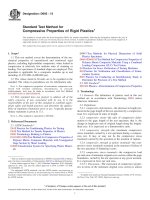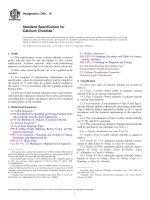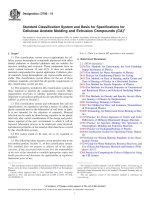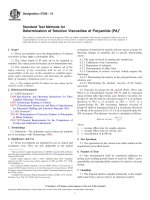Astm d 531 15
Bạn đang xem bản rút gọn của tài liệu. Xem và tải ngay bản đầy đủ của tài liệu tại đây (104.33 KB, 4 trang )
Designation: D531 − 15
Standard Test Method for
Rubber Property—Pusey and Jones Indentation1
This standard is issued under the fixed designation D531; the number immediately following the designation indicates the year of
original adoption or, in the case of revision, the year of last revision. A number in parentheses indicates the year of last reapproval. A
superscript epsilon (´) indicates an editorial change since the last revision or reapproval.
This standard has been approved for use by agencies of the U.S. Department of Defense.
3.2 The indentation value obtained should not be confused
with hardness as measured by Test Method D1415, since in the
latter test the rubber immediately adjacent to the indentor is
precompressed.
1. Scope
1.1 This test method covers the determination of the indentation of rubber or rubber-like materials by means of the Pusey
and Jones type of plastometer. This apparatus is used to
measure the depth of indentation of an indentor, under fixed
force into the surface of a specimen.
4. Apparatus
4.1 Plastometer, an instrument consisting of an indentor, a
mass for applying the stated force on the indentor, a micrometer for indicating the depth of the indentation, a specimen
holder and support.
4.1.1 Indentor, for indenting the specimen, consisting of a
vertical steel shaft attached, at the upper end to a depth
indicator gage, and terminating in a steel sphere having a
diameter of 3.175 6 0.015 mm (0.1250 6 0.0005 in.) of
polished, noncorrosive hard metal treated to resist wear.
4.1.2 Mass, the mass shall be 1000 6 0.01 g.
4.1.3 Depth Indicator Gage, a micrometer attached to the
plastometer, either an electronic digital gage or analog dial
gage, capable of displaying indentor movement (indentation)
in increments of at least 0.01 mm (0.0004 in.) and having travel
of 0 (zero) to no less than 3 mm (0.12 in).
4.1.4 Support, a support frame, or fixture, for the
plastometer, shall be configured so that the specimen holder
and hence, the specimen, are perpendicular to the indentor
support shaft and that the mass may be independently raised or
lowered vertically, permitting the indentor to rest on the
surface of the specimen and the mass to be subsequently
applied.
4.1.5 Specimen Holder, for the standard, or reference specimen described in 5.1, shall consist of a clamping fixture of two
metal plates secured by two threaded bolts. The uppermost
plate shall have a hole and a slot, as depicted in Fig. 1, to allow
for the unencumbered introduction of the indentor to the
specimen.
4.1.5.1 The purpose of the specimen holder is to support the
specimen in a manner that reduces, or eliminates, relative
positioning or movement that may adversely affect test determinations.
4.1.5.2 In routine testing, a specimen holder, a support, or
both, of other, but similar, configurations may be employed to
accommodate specimens other than those described in 5.1,
refer to 5.1.1.
1.2 The values stated in SI units are to be regarded as the
standard.
1.3 This standard does not purport to address all of the
safety concerns, if any, associated with its use. It is the
responsibility of the user of this standard to establish appropriate safety and health practices and determine the applicability of regulatory limitations prior to use.
2. Referenced Documents
2.1 ASTM Standards:2
D1349 Practice for Rubber—Standard Conditions for Testing
D1415 Test Method for Rubber Property—International
Hardness
D4483 Practice for Evaluating Precision for Test Method
Standards in the Rubber and Carbon Black Manufacturing
Industries
NOTE 1—The specific dated edition of the practice that prevails in this
document is referenced in the Section 9.
3. Significance and Use
3.1 The Pusey and Jones indentation value is the depth of
indentation, expressed in hundredths of a millimetre, of a ball
3.175 mm (0.1250 in.) in diameter under an expressed force of
9.8 N (2.2 lbf). This value may be used to compare the
indentation resistance of rubber and rubber-like materials.
1
This test method is under the jurisdiction of ASTM Commitee D11 on Rubber
and is the direct responsibility of Subcommittee D11.10 on Physical Testing.
Current edition approved Aug. 1, 2015. Published January 2016. Originally
approved in 1939. Last previous edition approved in 2010 as D531 – 00 (2010).
DOI: 10.1520/D0531-15.
2
For referenced ASTM standards, visit the ASTM website, www.astm.org, or
contact ASTM Customer Service at For Annual Book of ASTM
Standards volume information, refer to the standard’s Document Summary page on
the ASTM website.
Copyright © ASTM International, 100 Barr Harbor Drive, PO Box C700, West Conshohocken, PA 19428-2959. United States
1
D531 − 15
mm
A, min
B, min
D
E
F
80
30
17 to 18
11 to 12
60
in.
3.15
1.2
0.67 to 0.70
0.43 to 0.47
2.36
FIG. 1 Holder for Test Specimens
6.1.5.2 Adjust the depth indicator gage so the display
indicates zero.
6.1.6 Lower the mass onto the indentor, in a fashion that
eliminates shock, until the mass rests fully on the indentor.
6.1.7 The amount of indentation displayed on the depth
indicator gage 60 s (61 s) after the application of a total force
of 9.8 N, shall be recorded.
6.1.8 Make no less than 3 such determinations on the
specimen at least 13 mm (0.51 in) apart and from any edge.
6.1.9 The median of the determinations, expressed as a
whole number indicating hundredths of millimetres, shall be
reported as the Pusey and Jones Indentation Value, refer to
8.1.1.
5. Test Specimens
5.1 The standard, or reference, test specimen shall be a
uniform molded rectangular block a minimum of 13 mm (0.51
in.) in thickness, 30 mm (1.18 in.) in width, and 75 mm (2.95
in.) in length. The upper and lower surfaces, those opposite
surfaces with the largest area, shall be parallel to within 60.5
mm (60.20 in).
5.1.1 The standard, or reference, test specimen shall be used
when the plastometer is employed for the purpose of determining a standard, or reference, either within or between
laboratories, that is, in other than routine testing.
5.2 In routine testing, specimens may be used with a
configuration other than those of the standard, or reference, test
specimen described in 5.1.
6.2 Measurement of Indentation of Specimens for Routine
Tests (Nonstandard Specimens):
6.2.1 When making determinations on specimens other than
those described in 5.1, specimen holders, supports or other
suitable fixturing, similar to those previously described, may be
employed and the procedure in 6.1 may be followed, otherwise:
6.2.2 Mount the plastometer over, or directly upon, the
specimen, so that the indentor shaft is vertical and perpendicular to the specimen surface and both are level, as determined by
means of a spirit level or similar device.
6.2.3 Position curved (convex or concave) or irregularly
shaped specimens, so that the center line of the indentor shaft
is perpendicular to the tangent of the specimen at the point of
contact of the indentor and that determinations shall be made in
accordance with 6.2.8.
6.2.4 The plastometer and specimen, or any fixtures
employed, shall be secure and situated in a manner that
prevents unsteadiness or movement other than described in 6.3.
6.2.5 Lower the indentor shaft until the indentor is at the
moment of contact with the specimen.
6. Procedure
6.1 Measurement of Indentation of Standard, or Reference
Specimens:
6.1.1 When measuring the indentation on a standard, or
reference specimen as described in 5.1, secure it in the
specimen holder (refer to Fig. 1 and Section 4.1.5) with the
bolts tightened sufficiently to hold it firmly without measurable
compression.
6.1.2 Place the specimen holder on the support.
6.1.3 Mount the plastometer over the specimen so that the
indentor shaft is perpendicular to the support and hence the
specimen holder, to within 60.05 mm (60.002 in).
6.1.4 The plastometer and support shall be placed upon a
flat surface in a manner that prevents unsteadiness or movement other than described in 6.3.
6.1.5 Lower the indentor shaft until the indentor is at the
moment of contact with the specimen.
6.1.5.1 Adjust the depth indicator gage to record indentations up to 3 mm (0.12 in).
2
D531 − 15
TABLE 1 Special Precision Results—Pusey and Jones Indentation
Material
Mean Level
1
2
3
4
11.7(a)
20.9
38.1
63.0
Within InstrumentA
Between InstrumentA
S(w)
r(w)
(r)(w)
S(B)
r(B)
(r)(B)
0.265
0.296
0.379
0.192
0.750
0.838
1.073
0.543
6.4
4.0
2.8
0.86
0.374
0.309
0.668
1.67
1.06
0.875
1.89
4.73
9.1
4.2
5.0
7.5
A
S(w) = within instrument, standard deviation.
r(w) = repeatability (within instrument) measurement units.
(r)(w) = repeatability (within instrument), %.
S(B) = between instrument, standard deviation.
r(B) = repeatability (between instrument) measurement units.
(r)(B) = repeatability (between instrument), %.
(a) = Pusey and Jones indentation number.
7. Laboratory Atmosphere and Test Specimen
Conditioning
6.2.5.1 Adjust the depth indicator gage to record indentations up to 3 mm (0.12 in).
6.2.5.2 Adjust the depth indicator gage so the display
indicates zero.
6.2.6 Lower the mass onto the indentor, in a fashion that
eliminates shock, until the mass rests fully on the indentor.
6.2.7 The amount of indentation displayed on the depth
indicator gage 60 s (61 s) after the application of a total force
of 9.8 N, shall be recorded.
6.2.8 Make no less than 3 such determinations on the
specimen at least 13 mm (0.51 in) apart and from any edge.
6.2.9 The median of the determinations, expressed as a
whole number indicating hundredths of millimetres, shall be
reported as the Pusey and Jones Indentation Value, refer to
8.1.1.
6.2.10 When tests are performed on specimens other than
those described in 5.1 and without the specimen holder and
support the results shall be compared only to those obtained on
similarly configured specimens under similar conditions.
7.1 The tests shall be conducted in the standard laboratory
atmosphere as defined in Practice D1349, Terminology: “standard laboratory atmosphere.”
7.2 Test specimen conditioning shall be in accordance with
Practice D1349, Section 5 Conditioning of Materials for
Testing.
7.3 These conditions may be modified if agreed upon
between laboratories or between supplier and user and are in
accord with the alternative procedures described in Practice
D1349.
7.4 When tests are conducted, within a laboratory, for
purposes of research, development, or empirical study and
reported beyond that laboratory, the conditions shall be reported in accordance with Practice D1349.
8. Report
6.3 Vibrator—A small vibrator that is activated prior to the
mass being applied to the indentor and operates continuously
during a test to overcome any friction in the apparatus. An
instrument that vibrates approximately 120 times per s, with an
amplitude of vibration of the fixed platform of the tester
varying from approximately 0.002 to 0.005 mm (0.0001 to
0.0002 in.), has been found satisfactory.
8.1 State that the test was made in accordance with this
designation and include the following information:
8.1.1 The Pusey and Jones indentation number,
8.1.2 Description of test specimen including dimensions,
8.1.3 Date of vulcanization, if known,
8.1.4 Duration and temperature of vulcanization, if known,
8.1.5 Temperature of test room, and
8.1.6 Date of test.
6.4 Such a vibrator may consist of a simple-cored solenoid
fastened to the top of a C-shaped piece of strap steel. The lower
part of the solenoid core is a loose cylindrical piece of steel
with a shoulder at its lower end. When the current is off, the
loose-cored section rests on a screw projecting from the bottom
of the C-shaped support. When the current is on, the loosecored section is attached to the solenoid but is restrained by a
flat split ring of spring brass through which the cored section
passes, and which bears on the shoulder of the cored section.
The cored section is caused to vibrate by the alternating forces
of attraction by the solenoid and repulsion by the flat ring
acting as a spring. A small plate bearing a toggle switch for
closing the circuit to the solenoid is fastened to the top of the
C-shaped piece of strap steel by means of the same bolt that
holds the solenoid. The bottom of the C-shaped piece is
fastened by screws to a portion of a brass nut that serves to
clamp the vibrator to one upright post of the tester.
9. Precision and Bias3
9.1 These precision statements have been prepared in accordance with Practice D4483. Refer to Practice D4483 for
terminology and other testing and statistical concepts.
9.2 The Pusey and Jones Indentation Plastometer is used
mainly in the rubber roll industry. In this program no interlaboratory precision data were obtained due to the limited use
of this test method. The precision program consisted of tests by
one operator on three different (in-house) instruments on three
different days. Four materials were tested. A test result is the
median value of three separate (determinations) indentation
measurements.
3
Supporting data have been filed at ASTM International Headquarters and may
be obtained by requesting Research Report RR:D11-1028.
3
D531 − 15
9.3 Table 1 gives the within and among “instrument”
precision. Repeatability refers to within instrument variation;
reproducibility refers to among (between) instrument variation,
with the same operator for both.
10. Keywords
10.1 hardness; indentation hardness; relative hardness; plastometer
9.4 Bias—In test method statistical terminology, bias is the
difference between an average test value and the reference or
true test property value. Reference values do not exist for this
test method since the value or level of the test property is
exclusively defined by the test method. Bias, therefore, cannot
be determined.
ASTM International takes no position respecting the validity of any patent rights asserted in connection with any item mentioned
in this standard. Users of this standard are expressly advised that determination of the validity of any such patent rights, and the risk
of infringement of such rights, are entirely their own responsibility.
This standard is subject to revision at any time by the responsible technical committee and must be reviewed every five years and
if not revised, either reapproved or withdrawn. Your comments are invited either for revision of this standard or for additional standards
and should be addressed to ASTM International Headquarters. Your comments will receive careful consideration at a meeting of the
responsible technical committee, which you may attend. If you feel that your comments have not received a fair hearing you should
make your views known to the ASTM Committee on Standards, at the address shown below.
This standard is copyrighted by ASTM International, 100 Barr Harbor Drive, PO Box C700, West Conshohocken, PA 19428-2959,
United States. Individual reprints (single or multiple copies) of this standard may be obtained by contacting ASTM at the above
address or at 610-832-9585 (phone), 610-832-9555 (fax), or (e-mail); or through the ASTM website
(www.astm.org). Permission rights to photocopy the standard may also be secured from the Copyright Clearance Center, 222
Rosewood Drive, Danvers, MA 01923, Tel: (978) 646-2600; />
4









